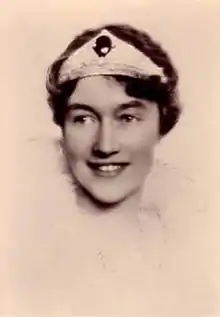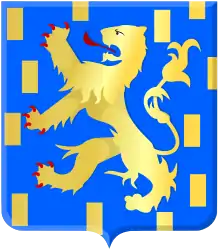Charlotte, Grand Duchess of Luxembourg
Charlotte (Charlotte Adelgonde Élise/Elisabeth Marie Wilhelmine; 23 January 1896 – 9 July 1985) reigned as Grand Duchess of Luxembourg from 1919 until her abdication in 1964.
| Charlotte | |||||
|---|---|---|---|---|---|
 The Grand Duchess in 1942 | |||||
| Grand Duchess of Luxembourg | |||||
| Reign | 14 January 1919 – 12 November 1964 | ||||
| Predecessor | Marie-Adélaïde | ||||
| Successor | Jean | ||||
| Prime ministers | |||||
| Born | 23 January 1896 Berg Castle, Luxembourg | ||||
| Died | 9 July 1985 (aged 89) Fischbach Castle, Fischbach, Luxembourg | ||||
| Burial | |||||
| Spouse | Prince Felix of Bourbon-Parma | ||||
| Issue | |||||
| |||||
| House | Nassau-Weilburg | ||||
| Father | William IV, Grand Duke of Luxembourg | ||||
| Mother | Infanta Marie Anne of Portugal | ||||
| Religion | Catholicism | ||||
She acceded to the throne on 14 January 1919 following the abdication of her sister, Marie-Adélaïde, due to political pressure over Marie-Adélaïde's role during the German occupation of Luxembourg during World War I. A referendum retained the monarchy with Charlotte as grand duchess.
She married Prince Felix of Bourbon-Parma on 6 November 1919. They had six children. Following the 1940 German invasion of Luxembourg during World War II, Charlotte went into exile: first in France, then Portugal, Great Britain, and North America. While in Britain, she made broadcasts to the people of Luxembourg. She returned to Luxembourg in April 1945.
She abdicated in 1964, and was succeeded by her son Jean. Charlotte died from cancer on 9 July 1985. She was the last agnatic member of the House of Nassau. She was the last personal recipient of the Golden Rose and since her death there are no living personal recipients of that honour, which in modern times has been awarded only to churches and shrines.
Early life and tenure as Grand Duchess

Born in Berg Castle, Charlotte of Nassau-Weilburg, Princess of Luxembourg, was the second daughter of Grand Duke William IV and his wife, Marie Anne of Portugal.
Her older sister, Marie-Adélaide, had succeeded their father. However, Marie-Adélaïde's actions had become controversial, and she was seen as friendly to the German occupation of Luxembourg during World War I. There were calls in parliament for her abdication, and she was forced to abdicate on 14 January 1919.
Charlotte became the one who had to deal with the revolutionary tendencies in the country. Unlike her sister, she chose not to interfere in its politics.
Luxembourg adopted a new constitution that year. In a referendum on 28 September 1919, 77.8% of the Luxembourgish people voted for the continuation of the monarchy with Grand Duchess Charlotte as head of state. However, in the new constitution, the powers of the monarch was severely restricted.
Reign
By 1935, Charlotte had sold her German properties, the former residential palaces of the Dukes of Nassau, Biebrich Palace and Schloss Weilburg, to the State of Prussia. During World War II the grand ducal family left Luxembourg shortly before the arrival of Nazi troops. Luxembourg's neutrality was violated on 9 May 1940, while the Grand Duchess and her family were in residence at Colmar-Berg. That day she called an extraordinary meeting of her leading ministers, and they all decided to place themselves under the protection of France, described by the Grand Duchess as a difficult but necessary decision. Initially the family took up residence at the Château de Montastruc in south-western France, but the rapid advance of the German forces into France followed by French capitulation the next month caused the French government to refuse any guarantee of security to the exiled Luxembourg government. Permission was received to cross Spain provided they did not stop en route, and the Grand Duchess with her ministers moved on to Portugal.
The Germans proposed to restore the Grand Duchess to her functions, but Charlotte refused, mindful of her sister's experiences of remaining in Luxembourg under German occupation during the First World War. By 29 August 1940 Grand Duchess Charlotte was in London where she began to make supportive broadcasts to her homeland using the BBC. Later she travelled to the United States and to Canada. Her children continued their schooling in Montreal while she had several meetings with President Roosevelt who encouraged her itinerant campaigning across the country in support of his own opposition to isolationism which was a powerful political current until the Pearl Harbor attacks. In the meantime Luxembourg, along with the adjacent French Moselle department, found itself integrated into an expanded Germany under the name Heim ins Reich, which left Luxembourgers required to speak German and liable for conscription into the German army.
In 1943 Grand Duchess Charlotte and the Luxembourg government established themselves in London: her broadcasts became a more regular feature of the BBC schedules, establishing her as a focus for the resistance movements in Luxembourg. The Grand Ducal family went to North America in exile, settling first on the Marjorie Merriweather Post estate in Brookville, Long Island and then in Montreal. The Grand Duchess visited Washington DC and made a goodwill tour of the US to keep the profile of Luxembourg high in the eyes of the Allies.[1]
Charlotte's younger sister Antonia and brother-in-law Rupprecht, Crown Prince of Bavaria, were exiled from Germany in 1939. In 1944, living now in Hungary, Crown Princess Antonia was captured when the Germans invaded Hungary and found herself deported to the concentration camp at Dachau, being later transferred to Flossenbürg where she survived torture but only with her health badly impaired. Meanwhile, from 1942 Grand Duchess Charlotte's eldest son, Jean, served as a volunteer in the Irish Guards.
In the years after the war, Charlotte showed a lot of public activity which contributed to raising Luxembourg's profile on the international stage, by hosting visits from foreign heads of state and other dignitaries, such as Eleanor Roosevelt (1950), Queen Juliana of the Netherlands (1951), René Coty (1957), King Baudouin of Belgium (1959), King Bhumibol of Thailand (1961), and King Olav V of Norway (1964). Likewise, she visited Pius XII (1950), Charles de Gaulle (1961), and John F. Kennedy (1963).[2]
In 1951 Charlotte and her prime minister Pierre Dupong by decree admitted into the nobility of Luxembourg three Swedish relatives who were not allowed to use their birth titles in Sweden. They were then named as Sigvard Prince Bernadotte, Carl Johan Prince Bernadotte and Lennart Prince Bernadotte and also, with their legitimate descendants, were given the hereditary titles of Counts and Countesses of Wisborg there.[3]
Abdication and later life

On 12 November 1964, she abdicated in favour of her son Jean, who then reigned until his abdication in 2000.
Charlotte died at Schloss Fischbach on 9 July 1985, from cancer. She was interred in the Ducal Crypt of the Notre-Dame Cathedral in the city of Luxembourg.
A statue of the Grand Duchess is in Place Clarefontaine in the city of Luxembourg.[4]
Marriage and children
On 6 November 1919 in Luxembourg, she married Prince Felix of Bourbon-Parma, a first cousin on her mother's side. (Both Charlotte and Felix were grandchildren of King Miguel of Portugal, through his daughters Maria Anna and Maria Antonia, respectively). With the marriage, their lineal descent was raised in style from Grand Ducal Highness to Royal Highness. The union produced six children, twenty-seven grandchildren, seventy-eight great-grandchildren, and thirty-five great-great-grandchildren:
| Name | Date of birth | Date of death | Spouses |
|---|---|---|---|
| Jean, Grand Duke of Luxembourg | 5 January 1921 | 23 April 2019 (aged 98) | Princess Joséphine-Charlotte of Belgium (1927–2005). They had five children, twenty-two grandchildren and eight great-grandchildren |
| Princess Elisabeth, Duchess von Hohenberg | 22 December 1922 | 22 November 2011 (aged 88) | Franz, Duke von Hohenberg (1927–1977), and they have two daughters, seven grandchildren and seven great-grandchildren. |
| Princess Marie Adelaide, Countess Henckel von Donnersmarck | 21 May 1924 | 28 February 2007 (aged 82) | Count Karl Josef Henckel von Donnersmarck (1928–2008) and they have four children and eight grandchildren. |
| Princess Marie Gabriele, Dowager Countess af Holstein-Ledreborg | 2 August 1925 | Knud Johan, Count af Holstein-Ledreborg (1919–2001) and they have seven daughters, fifteen grandchildren and ten great-grandchildren. | |
| Prince Charles of Luxembourg | 7 August 1927 | 26 July 1977 (aged 49) | Joan Douglas Dillon (b. 1935) and they have two children and six grandchildren. |
| Alix, Dowager Princess de Ligne | 24 August 1929 | 11 February 2019 (aged 89) | Antoine, 13th Prince de Ligne (1925–2005) and they have seven children, twenty grandchildren and ten great-grandchildren. |
Titles, styles, and honours
| Styles of Charlotte, Grand Duchess of Luxembourg | |
|---|---|
| Reference style | Her Royal Highness |
| Spoken style | Your Royal Highness |
Titles
- 23 January 1896 – 25 February 1912: Her Grand Ducal Highness Princess Charlotte of Luxembourg
- 25 February 1912 – 14 January 1919: Her Royal Highness The Hereditary Grand Duchess of Luxembourg[5]
- 14 January 1919 – 12 November 1964: Her Royal Highness The Grand Duchess of Luxembourg
- 12 November 1964 – 9 July 1985: Her Royal Highness Grand Duchess Charlotte of Luxembourg
Honours
- National honours
 Luxembourg:
Luxembourg:
- Knight Grand Cross of the Order of the Gold Lion of the House of Nassau[6]
- Knight Grand Cross of the Order of Adolphe of Nassau[7][8]
- Knight Grand Cross of the Order of the Oak Crown[9]
- Knight Grand Cross of the Order of Merit of the Grand Duchy of Luxembourg[10]
- Recipient of the Luxembourg War Cross
- Foreign honours
- Austria
.svg.png.webp) Austria-Hungary: Dame of the Order of the Starry Cross, 1st Class
Austria-Hungary: Dame of the Order of the Starry Cross, 1st Class Austrian Republic: Grand Cross of the Decoration for Services to the Republic of Austria
Austrian Republic: Grand Cross of the Decoration for Services to the Republic of Austria
.svg.png.webp) Belgium: Knight Grand Cordon of the Royal Order of Leopold[9]
Belgium: Knight Grand Cordon of the Royal Order of Leopold[9] Denmark: Knight of the Order of the Elephant - 21 March 1955[11]
Denmark: Knight of the Order of the Elephant - 21 March 1955[11].svg.png.webp) France: Grand Cross of the Legion of Honour - 22 June 1923[12]
France: Grand Cross of the Legion of Honour - 22 June 1923[12] Holy See:
Holy See:
- Dame Grand Cross of the Order of Pius IX
- Cross of Honour of the "Pro Ecclesia et Pontifice"
- The Golden Rose
- Italy:
 Parmese Ducal Family: Dame Grand Cross of the Sacred Military Constantinian Order of Saint George
Parmese Ducal Family: Dame Grand Cross of the Sacred Military Constantinian Order of Saint George
.svg.png.webp) Nazi Germany: Grand Officer of the Order of Social Welfare, Special Class
Nazi Germany: Grand Officer of the Order of Social Welfare, Special Class Netherlands: Knight Grand Cross of the Order of the Netherlands Lion[9][13]
Netherlands: Knight Grand Cross of the Order of the Netherlands Lion[9][13] Norway: Knight Grand Cross of the Order of St. Olav
Norway: Knight Grand Cross of the Order of St. Olav Poland: Grand Cross of the Order of the White Eagle[9]
Poland: Grand Cross of the Order of the White Eagle[9] Portugal:
Portugal:
- Dame Grand Cross of the Order of the Tower and Sword - 29 September 1933
- Grand Cross of the Sash of the Two Orders - 23 January 1949[14]
 Spain : Dame Grand Cross of the Royal and Distinguished Order of Charles III
Spain : Dame Grand Cross of the Royal and Distinguished Order of Charles III Sweden: Member of the Order of the Seraphim - 14 April 1939[15]
Sweden: Member of the Order of the Seraphim - 14 April 1939[15] Thailand: Dame of the Order of the Royal House of Chakri - 17 October 1965[16]
Thailand: Dame of the Order of the Royal House of Chakri - 17 October 1965[16]
Gallery
- Click on image to enlarge
 The old Berg Castle (demolished 1906), Mersch, central Luxembourg, ducal residence where Charlotte was born
The old Berg Castle (demolished 1906), Mersch, central Luxembourg, ducal residence where Charlotte was born Fischbach Castle, Mersch, Charlotte's residence, and where she died
Fischbach Castle, Mersch, Charlotte's residence, and where she died Statue of Grand-Duchess Charlotte in Clairefontaine square, side view
Statue of Grand-Duchess Charlotte in Clairefontaine square, side view
Ancestry
| Ancestors of Charlotte, Grand Duchess of Luxembourg |
|---|
Notes and references
- "Grand Duchess Charlotte's US Good-Will-Tours". Luxemburger Wort. 14 April 2015. Retrieved 21 December 2015.
- Kreins, Jean-Marie. Histoire du Luxembourg. Paris: Presses Universitaires de France, 2010. 5th edition. p. 105
- "Mémorial A n° 48 de 1951 - Legilux" (PDF). Archived from the original (PDF) on 21 July 2015. Retrieved 7 May 2016.
- "Commemoration to mark return of Luxembourg monarch". Luxemburger Wort. 11 April 2015. Retrieved 21 December 2015.
- It was customary for a reigning Grand Duke, his heir apparent, and their spouses to use the style of Royal Highness
- http://www.luxcentral.com/art/rulers/Charlotte.gif
- "Wedding Wednesday: November Brides". orderofsplendor.blogspot.co.uk.
- "Grand Duchess Charlotte of Luxemburg". alexanderpalace.org.
- "The Royal Order of Sartorial Splendor: Wedding Wednesday: November Brides". orderofsplendor.blogspot.co.uk.
- Jørgen Pedersen (2009). Riddere af Elefantordenen, 1559–2009 (in Danish). Syddansk Universitetsforlag. p. 466. ISBN 978-87-7674-434-2.
- M. & B. Wattel (2009). Les Grand'Croix de la Légion d'honneur de 1805 à nos jours. Titulaires français et étrangers. Paris: Archives & Culture. pp. 21, 489, 615. ISBN 978-2-35077-135-9.CS1 maint: uses authors parameter (link)
- "Geheugen van Nederland".
- "Banda da Grã-Cruz das Duas Ordens: Carlota Aldegundes Elisa Maria Guilhermina (Grã-Duquesa do Luxemburgo e Duquesa de Nassau)" (in Portuguese), Arquivo Histórico da Presidência da República. Retrieved 2 April 2020.
- Sveriges statskalender (in Swedish), II, 1940, p. 8, retrieved 2 April 2020 – via runeberg.org
- Royal Thai Government Gazette (28 December 1964). "แจ้งความสำนักนายกรัฐมนตรี พระราชทานเครื่องขัตติยราชอิสริยาภรณ์มหาจักรีบรมราชวงศ์" (PDF) (in Thai). Retrieved 8 May 2019. Cite journal requires
|journal=(help)
External links
| Wikimedia Commons has media related to Charlotte, Grand Duchess of Luxembourg. |
Charlotte, Grand Duchess of Luxembourg Cadet branch of the House of Nassau Born: 23 January 1896 Died: 6 July 1985 | ||
| Regnal titles | ||
|---|---|---|
| Preceded by Marie-Adélaïde |
Grand Duchess of Luxembourg 1919–1964 |
Succeeded by Jean |
.svg.png.webp)



